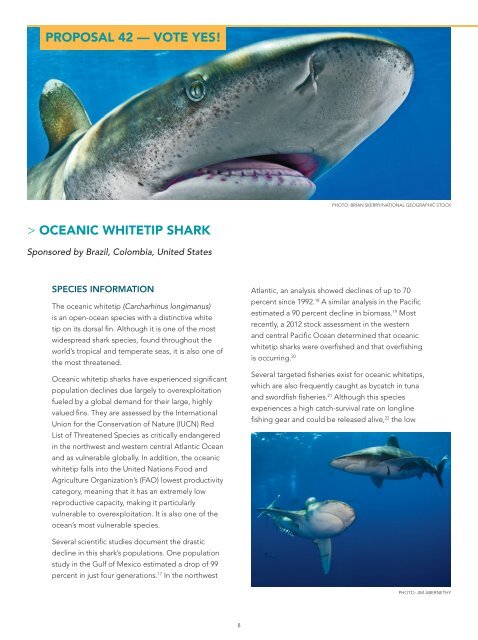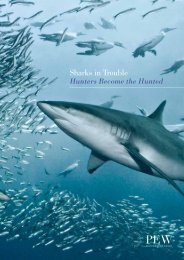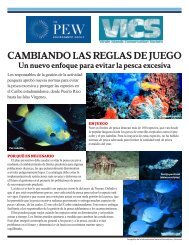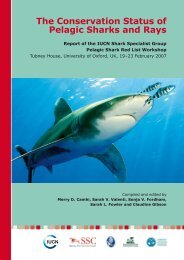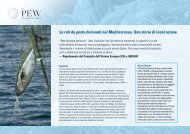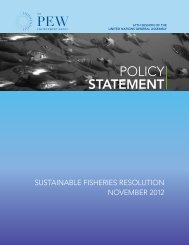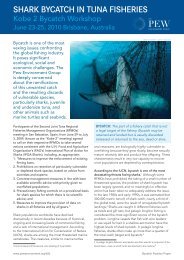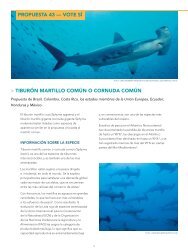CITES 2013: Oceanic Whitetip Shark (PDF)
CITES 2013: Oceanic Whitetip Shark (PDF)
CITES 2013: Oceanic Whitetip Shark (PDF)
You also want an ePaper? Increase the reach of your titles
YUMPU automatically turns print PDFs into web optimized ePapers that Google loves.
PROPOSAL 42 — VOTE YES!<br />
PHOTO: BRIAN SKERRY/NATIONAL GEOGRAPHIC STOCK<br />
> OCEANIC WHITETIP SHARK<br />
Sponsored by Brazil, Colombia, United States<br />
SPECIES INFORMATION<br />
The oceanic whitetip (Carcharhinus longimanus)<br />
is an open-ocean species with a distinctive white<br />
tip on its dorsal fin. Although it is one of the most<br />
widespread shark species, found throughout the<br />
world’s tropical and temperate seas, it is also one of<br />
the most threatened.<br />
<strong>Oceanic</strong> whitetip sharks have experienced significant<br />
population declines due largely to overexploitation<br />
fueled by a global demand for their large, highly<br />
valued fins. They are assessed by the International<br />
Union for the Conservation of Nature (IUCN) Red<br />
List of Threatened Species as critically endangered<br />
in the northwest and western central Atlantic Ocean<br />
and as vulnerable globally. In addition, the oceanic<br />
whitetip falls into the United Nations Food and<br />
Agriculture Organization’s (FAO) lowest productivity<br />
category, meaning that it has an extremely low<br />
reproductive capacity, making it particularly<br />
vulnerable to overexploitation. It is also one of the<br />
ocean’s most vulnerable species.<br />
Atlantic, an analysis showed declines of up to 70<br />
percent since 1992. 18 A similar analysis in the Pacific<br />
estimated a 90 percent decline in biomass. 19 Most<br />
recently, a 2012 stock assessment in the western<br />
and central Pacific Ocean determined that oceanic<br />
whitetip sharks were overfished and that overfishing<br />
is occurring. 20<br />
Several targeted fisheries exist for oceanic whitetips,<br />
which are also frequently caught as bycatch in tuna<br />
and swordfish fisheries. 21 Although this species<br />
experiences a high catch-survival rate on longline<br />
fishing gear and could be released alive, 22 the low<br />
Several scientific studies document the drastic<br />
decline in this shark’s populations. One population<br />
study in the Gulf of Mexico estimated a drop of 99<br />
percent in just four generations. 17 In the northwest<br />
PHOTO: JIM ABERNETHY<br />
8
market value of its meat coupled with the high value<br />
of its fins often leads fishermen to instead remove<br />
the fins at sea and dispose of the carcass overboard.<br />
<strong>Oceanic</strong> whitetip fins are easily identified<br />
in trade by the white tips, rounded shape, and<br />
large size, making them one of the most distinctive<br />
products in the shark fin trade. Identification of<br />
these unprocessed fins can be done by visual<br />
observation alone, with a DNA study of fins showing<br />
that fin traders can identify oceanic whitetip fins<br />
with 100 percent accuracy. 23 These sharks make<br />
up approximately 1.8 percent of the identified<br />
fins entering the Hong Kong market. 24 From this<br />
information, scientists have estimated that 250,000<br />
to 1.3 million oceanic whitetips are killed worldwide<br />
per year for the fin trade. 25<br />
<strong>Oceanic</strong> whitetips are receiving some protection<br />
through recently agreed conservation and<br />
management measures by some regional fisheries<br />
management organizations (RFMOs). But these<br />
measures do not extend to the full range of the<br />
species, nor do they regulate international trade.<br />
Furthermore, these measures apply only to oceanic<br />
whitetip sharks taken in the specific fisheries<br />
covered by those particular RFMOs and only<br />
to the governments that are members of those<br />
RFMOs. Three regional fisheries management<br />
organizations—the International Commission for the<br />
Conservation of Atlantic Tunas, the Inter-American<br />
Tropical Tuna Commission, and the Western<br />
and Central Pacific Fisheries Commission—have<br />
prohibited the retention onboard, transshipment,<br />
and landing of oceanic whitetip sharks within<br />
their fisheries.<br />
BENEFITS OF A <strong>CITES</strong> LISTING<br />
A proposal to include the species in Appendix II was<br />
proposed at the 15th meeting of the Conference of<br />
the Parties (CoP15) and was endorsed by the FAO,<br />
the <strong>CITES</strong> Secretariat, and TRAFFIC/IUCN. However,<br />
at that time, the proposal was narrowly rejected.<br />
Although RFMOs have taken some conservation<br />
and management actions since CoP15, huge<br />
gaps in regulations remain, and enforcement and<br />
compliance are limited.<br />
Including oceanic whitetips in <strong>CITES</strong> Appendix II will<br />
help States enforce their domestic prohibitions and<br />
help contracting Parties to relevant RFMOs ensure<br />
compliance with existing management measures.<br />
An Appendix II listing is scientifically justified and<br />
essential to ensure that trade occurs only from legal<br />
and sustainable fisheries, and it would help facilitate<br />
data collection across the species’ range.<br />
WHITETIP<br />
9


